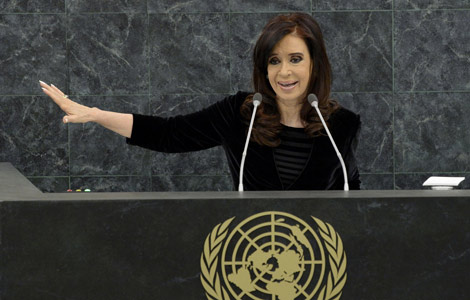Building a better population
Updated: 2013-09-26 07:59
By Noeleen Heyzer and Babatunde Osotimehin (China Daily)
|
|||||||||||
On issues of sexual and reproductive health and rights, great strides have been made in strengthening policy. Yet program implementation is lagging, particularly in targeting the most sexually active population group, namely youth.
Lack of information on sexual and reproductive health and limited access to related services are contributing to unintended pregnancies and unsafe abortions. These gaps are also exposing millions to the risk of HIV, in particular key populations, including people who inject drugs, prostitutes and their clients, homosexuals and transgenders. This means that comprehensive sex education and increased access to a range of contraceptives must be made a priority.
Moreover, sexual and reproductive health programs must also reach childless married women, and unmarried women and girls, as also men and boys, as part of an integrated public health system that combines curative, preventive and health promotion services.
Despite overall progress on maternal health, in some countries the number of women dying during childbirth still remains stubbornly high. There are parts of the region where one in 200 mothers dies giving birth.
Asian and Pacific countries must do better in adopting rights-based approaches to address population dynamics in their long-term plans for inclusive and sustainable development, including the impact of climate change. And most of all, the response to the region's challenges must be grounded in a commitment to addressing the unmet needs of women and all other groups that remain excluded from the development process.
How do we collectively tackle these new and persistent challenges? That question was put on the table at the Sixth Asian and Pacific Population Conference, which the Economic and Social Commission for Asia and the Pacific organized with UN Population Fund last week in Bangkok. The conference was part of, and will contribute to, the global ICPD 20-year review mandated by the UN.
As Asia-Pacific takes its place on the world stage, our governments have the means and the responsibility to build better lives for the region's 4.3 billion people. There is greater hope that the rapid population and development transformation will nurture the promise of a future that will be brighter than what had been predicted half a century ago.
Noeleen Heyzer is under-secretary-general of the UN and executive secretary of the Economic and Social Commission for Asia and the Pacific. Babatunde Osotimehin is under-secretary-general and executive director of the UN Population Fund.
(China Daily 09/26/2013 page9)
Related Stories
Population control of stray animals 2013-09-20 15:30
Beijing's migrant population shrinking 2013-09-18 13:30
World's ultra wealthy population reaches record high 2013-09-10 19:29
For an ideal population policy 2013-08-22 07:41
Today's Top News
UN resolution on Syria's chemical weapons urged
Death toll rises to 328 in SW Pakistan's quake
China, UK set to resume high-level dialogue
China reduces market intervention
Xi promotes 'mass line' campaign
China gaining military drones' share
Youth short on safe sex awareness
Station's priorities outlined
Hot Topics
Lunar probe , China growth forecasts, Emission rules get tougher, China seen through 'colored lens', International board,
Editor's Picks

|

|

|

|

|

|





